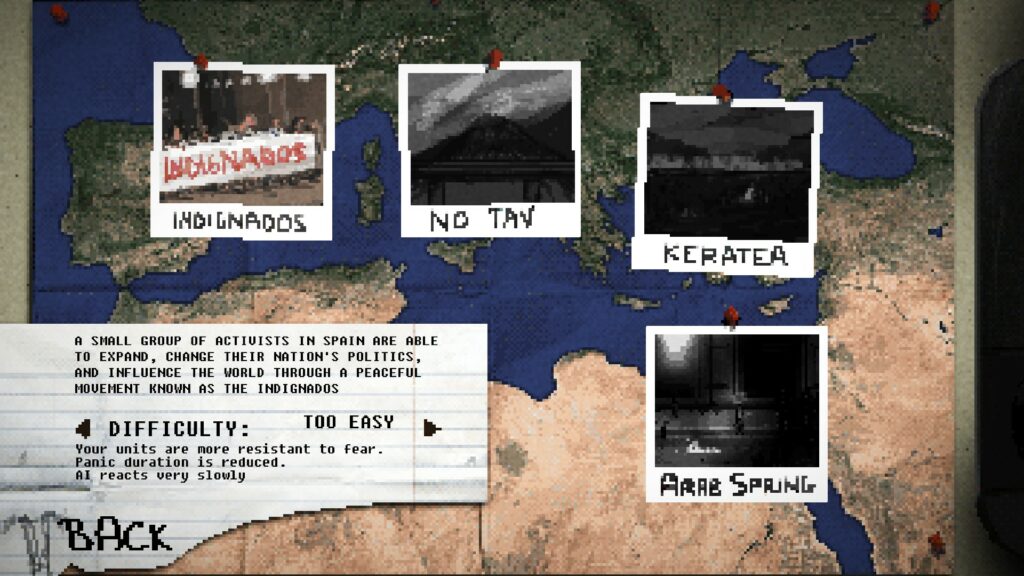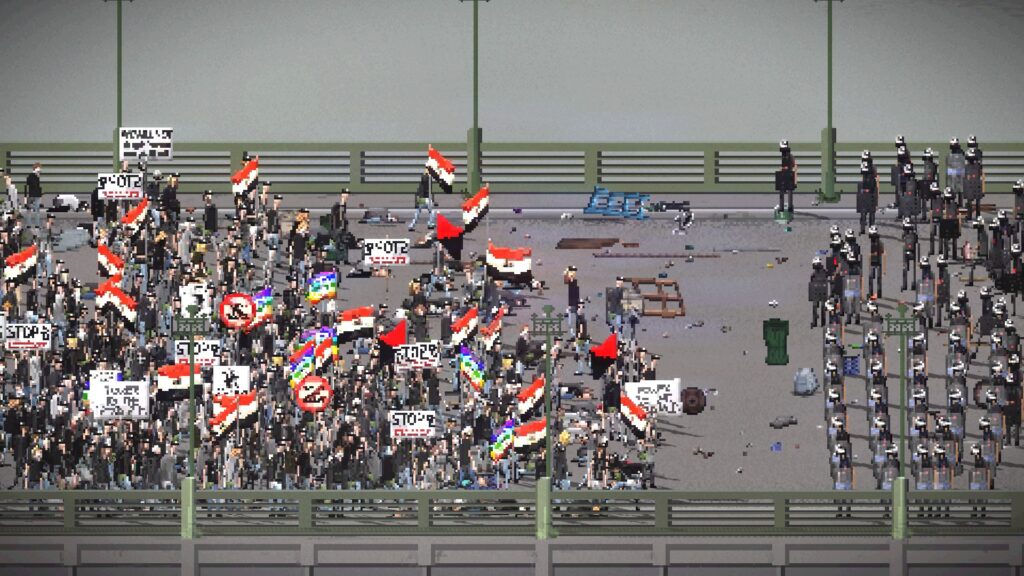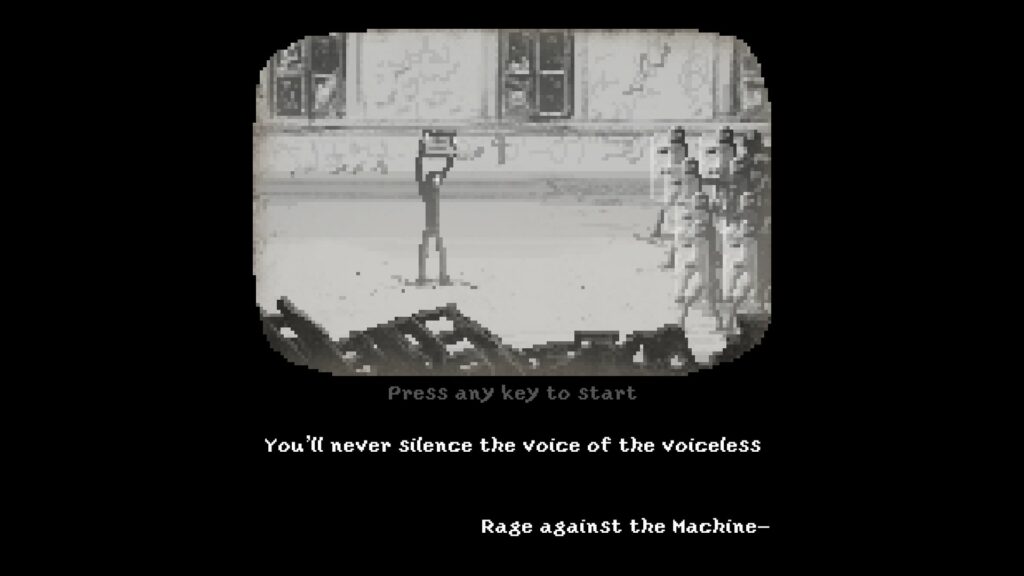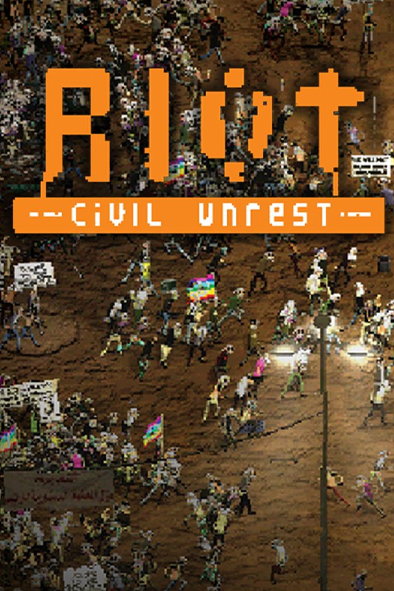It’s more than likely that you’ve never thought to yourself, “I wonder what an ANTIFA Rome Total War would look like,” but you’re definitely thinking of it now! Thanks to the developers at Merge Games, in collaboration with IV Productions, you can now somewhat live that out in their 2017 title RIOT: Civil Unrest.
Described as a “real-time riot simulator,” RIOT: Civil Unrest puts you directly in the driver’s seat of real-life uprisings in Italy, Spain, Greece and Egypt. You can choose your unit: rioters or police. Each unit comes equipped with weapons. For the rioters, you get to choose an assortment of items such as laser pointers, firecrackers, homemade paper bombs and of course, Molotov cocktails. For the police, you can choose typical police equipment like stun and tear gas grenades, batons, and so forth.
The game gives you specific missions based on your unit. Rioters’ missions include occupying public squares, forcibly expelling cops from encampments, and pushing past barricades. Police, of course, are given the task to deflect the resistance and hold the line. There are also time limits, so every single action you take, every decision you make, must count. The mechanics of the game are somewhat difficult to master, but we’ll discuss those a little later.

As stated before, RIOT: Civil Unrest is based on real-life events. In order to fully understand this game, we need to dive deeper into what pushed these citizens to their breaking point, to where guerilla resistance was their last resort after peaceful protests fell on deaf ears…
Indignados (Spain)
Also known as the 15-M movement, it should be no surprise the citizens of Spain organized to fight their oppressors. From May 2011 to March 2015, protests erupted in several major cities to oppose austerity measures which were brought up during the 2011 national election. Austerity measures are economic policies enforced by governments to raise taxes in order to reduce budget deficits. These taxes include gas, healthcare, even veteran benefits, and more. Policies such as this directly target working-class people and such policies have been the subject of uprisings around the world, such as France’s Yellow Vest movement and anti-austerity movements in Athens, Greece.
Sporting the slogan, “We are not goods in the hands of politicians and bankers,” an estimated 6-8.5 million citizens got involved, organized almost entirely by way of social media. In the months leading up to the protests, many of Spain’s trade unions, including anarcho-syndicalist unions, began calling for general strikes to protest the proposed policies. In May 2011, protests began as mostly peaceful occupations and sit-ins, that is, until Spain’s National Police started attacking and arresting peaceful protestors, an all-too-common scenario. This subsequently caused the more radical and riotouselements of the movement to materialize.
Closely mirroring the tactics of the anarcho-syndicalist trade union National Confederation of Labor (CNT) and militant anarchists in the Iberian Anarchist Federation (FAI) occupations of buildings in and around Catalonia during the outbreak of the Spanish Civil War, citizens in Portugal began occupying hospitals, creating police-free zones, and creating various worker cooperatives. Although many political reforms were won, the people of Spain also proved once more that a horizontally-organized society, one that is beyond the clutches of the State, is entirely possible. Just like in 1936.
Arab Spring (various nations)
At roughly the same time the Indignados movement began gaining popularity in Spain, another revolution was brewing in the Arab world. And it all began with a familiar sight: a lone wolf who became so fed up with economic stagnation and authoritarian rule that they took measures to address these issues that were so extreme the whole world collectively gasped in horror. That citizen was 26-year-old Tunisian street vendor Tarek el-Tayeb Mohamed Bouazizi. When local government officials claimed he had no vendor permit, his wares were confiscated. In late December 2010, after many failed appeals and, according to family members, even harassment by local politicians, Bouazizi stood in the middle of traffic, doused himself in gasoline, and dropped a lit match. He barely survived; 90% of his body was burnt to a near crisp.
While on life support, then-Tunisian president Zine El Abidine Ben Ali visited Bouazizi in the hospital and promised his family he would fly him out to France to receive medical treatment. This promise never materialized, much to the dismay of critics and eventual protestors. Bouazizi died on January 4th, 2011.
Immediately following Bouazizi’s death, tens of thousands of mostly working-class citizens hit the streets in protests in and around Tunisia, and eventually spread to Libya, Yemen, Syria, Bahrain and countless other Arab nations. The State, as per usual, attempted to silence the growing movement, predictably resulting in protests going from peaceful demonstrations to full-blown violent revolutions that eventually saw the reformation or overthrow of governments and exile of many nations’ top politicians. Less than two weeks after the Tunisian protests began, President Ben Ali stepped down. But the ensuing revolutions, which became known as the Arab Spring, continued.
The growing violent repression by governments and law enforcement slowly began to force the revolutions into submission by roughly mid-2012. Come December of that year, the Arab Spring was over. Many Arab nations saw different results: Morocco and Jordan saw constitutional reforms. In Libya, rebel fighters captured, tortured and executed Muammar Gaddafi, ending his 32-year rule. In Syria, civil unrest against Bashar al-Assad eventually exploded into a civil war that saw intervention from the United States and other world powers. And the list goes on. The Arab world was never the same.

No TAV (Italy)
Beginning in the 1990s, a movement sprung up in the metropolitan Susa Valley in Italy which sought resistance against the construction of high-speed railways. The movement became known as No TAV (Treno Alta Velocità) and is ongoing to this day. The purpose of this project was part of a larger European Union plan to directly connect to Ukraine along with various other countries and territories. Italian citizens had long-expressed concerns about construction displacing residents, damaging the environment, economic issues, etc. Despite this, their pleas were ignored, to no one’s surprise.
No TAV participants utilized many methods of resistance, including occupying and/or squatting government and construction company buildings, hunger strikes, sit-ins and other forms of civil disobedience. Many have even taken the liberty of supporting local agriculture over big industry, forcing production shipping to a near-stand-still by way of changing up distribution and schedules, organizing with students, and more.
To repeat, this movement is still ongoing. Hopefully, time will soon tell if the resistance can achieve more and more victories for the struggle.
Keratea (Greece)
Last, but certainly not least, we have the Keratea struggle in Greece. There have been too many radical movements to count coming out of Greece, most notably the anti-austerity uprisings primarily in Athens. Working-class Greeks have been at war with the State for years, so when the Greek government in 2010 decided to greenlight a landfill construction project in and around Keratea—that is, amidst a historic economic crisis—and send countless dozens of cops to preemptively stamp out an inevitable uprising, the Greeks did exactly what the Greeks have always done best in the face of tyranny: they fought back.
Practically overnight, everyone from the young to even the old became guerilla fighters. The townsfolk made it crystal clear that anyone who stands for the State shall fall for the State. In fact, this isn’t the first time something like this has happened. Similar protests were held in 2008 and 2009, in which a 43-year-old woman tragically died in the skirmishes. As you can probably tell, they weren’t down for a repeat.
Although the government decided to delay construction, the resistance didn’t let up, despite multiple citizens being arrested. Police were outnumbered and overwhelmed every single night. From the anti-austerity movement in Athens, to various construction protests, resistance against the Greek government continues to this day, and will likely never die out.
And now, I have a fun little theory I’d like to share: the police you can choose to play as are actually members of the Greek Communist Party (KKE), a Stalinist organization who are known collaborators with fascists and the State, who would much rather get into skirmishes with the anarchists and other political rivals than do anything worthwhile.
Final Thoughts
Riot: Civil Unrest is a pretty interesting educational tool. It gives players a sense of how chaotic the aforementioned uprisings were, while allowing them to choose how things play out. Sadly, the game is plagued with somewhat buggy and unresponsive AI, which is the game’s near-fatal flaw. What’s the most important aspect about any game? Control. If you feel like you have no control, any game is virtually unplayable. There were times when my AI units simply didn’t do what I wanted them to, didn’t move to where I wanted them to. During the rioters’ gameplay, my units occasionally retreated off screen and I had no choice or control over their actions, despite abusing the option to constantly call for reinforcements. It’s as if they just…gave up. It’s a feeling of powerlessness (and frustration) to be a gamer and feel like you have no control over your character(s).
Earlier I mentioned that the game’s mechanics are difficult to get used to, but it goes a bit further than that. There doesn’t seem to be an actual tutorial on how to control your rioters/police units. Even after watching a let’s-play on YouTube, I still had not much of a clue. You get to choose your equipment, and after a little bit of much-needed backstory about the events you’re reenacting, you’re dropped into the game and have less than a minute to figure out the controls before you’re overwhelmed by the opposing units. I still have absolutely no idea how I secured the few victories I did. It must have been pure luck. While playing as the rioters, I found myself desperately hurling Molotov cocktails and rocks every single chance I got, because I simply couldn’t keep my unit defense lines from falling apart or retreating. I found it was a lot easier to play as the police. All I had to do was form strategic riot control lines and throw flashbangs and tear gas to disperse crowds. Nothing much else to say about that. In fact, playing as the police was quite boring.
Last but not least, the game has an option where you get to create your own riot scenarios. It’s like Create-a-Park from the Tony Hawk’s Pro Skater franchise but more politically radical. The difference is that Create-a-Park, which was first introduced all the way back in 2000, was courteous enough to give you tips and tricks on how to customize your park. RIOT: Civil Unrest once again is lacking a coherent tutorial on how to customize your units and landscape, which is inexcusable for any modern title. As gamers, we aren’t asking game developers to hold our hands when we play. They also shouldn’t be damn-near cryptic about their games, either.
This game, while a very unique concept, is unavoidably flawed. I believe you’ll have a much more fun time watching actual riot footage on the internet. I give RIOT: Civil Unrest a 4/10. ■
Vincent Parsons


